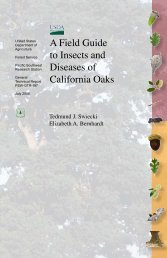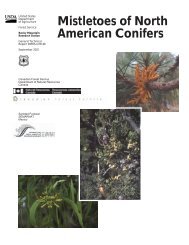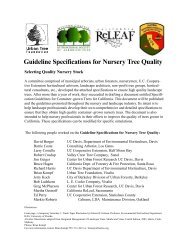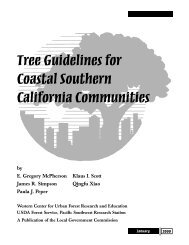2006. California Invasive Plant Inventory - Cal-IPC
2006. California Invasive Plant Inventory - Cal-IPC
2006. California Invasive Plant Inventory - Cal-IPC
You also want an ePaper? Increase the reach of your titles
YUMPU automatically turns print PDFs into web optimized ePapers that Google loves.
Figure 2. Jepson Geographic Regions<br />
CA-FP<br />
GB<br />
Northwest<br />
(NW)<br />
Central West<br />
(CW)<br />
Modoc Plateau (MP)<br />
Cascade Range (CaR)<br />
Sierra Nevada (SN)<br />
Eastern Sierra Nevada<br />
(SNE)<br />
GB<br />
D<br />
Mojave<br />
Desert<br />
(DMoj)<br />
CA = all of <strong><strong>Cal</strong>ifornia</strong><br />
CA-FP = <strong><strong>Cal</strong>ifornia</strong> Floristic Province<br />
(NW, CaR, SN, GV, CW, SW)<br />
GB = Great Basin Province<br />
(MP, SNE)<br />
D = Desert Province<br />
(DMoj, DSon)<br />
Great Valley<br />
(GV)<br />
Southwest<br />
(SW)<br />
CA-FP<br />
D<br />
Sonoran Desert<br />
(DSon)<br />
Reprinted from The Jepson Manual,<br />
J. Hickman, Ed., 1993, with permission<br />
from the Jepson Herbarium. © Regents<br />
of the University of <strong><strong>Cal</strong>ifornia</strong>.<br />
Table 2 contains four plants that are native to specific<br />
regions of <strong><strong>Cal</strong>ifornia</strong> but have become invasive<br />
in other regions of the state to which humans have<br />
moved them. Table 3 lists those plant species that<br />
were evaluated but did not meet the threshold for<br />
listing. Finally, Table 4 contains plants that were<br />
nominated for review but dismissed without a formal<br />
assessment because either they do not invade wildlands<br />
(except for isolated instances) or the <strong>Inventory</strong><br />
Review Committee lacked adequate information to<br />
answer the criteria questions.<br />
Table 1 summarizes rating information for all<br />
plant species categorized as invasive by this <strong>Inventory</strong>.<br />
The columns contain the following information:<br />
• A diamond (◆) in the first column designates an<br />
Alert status for that species.<br />
• Scientific nomenclature for most species follows<br />
The Jepson Manual. 4<br />
• For each species, the first common name is based<br />
on the Weed Science Society of America, 5 followed<br />
by other names commonly used in <strong><strong>Cal</strong>ifornia</strong>.<br />
(Appendix 4 provides an index of common names.)<br />
• The overall rating for the plant (High, Moderate,<br />
or Limited) is listed next. (Because Table 1 is organized<br />
alphabetically, we have included a listing<br />
organized by rating level in Appendix 1.)<br />
• Section scores are shown for Ecological Impact,<br />
<strong>Invasive</strong> Potential, and Distribution. These can<br />
typically be interpreted as A=high, B=moderate,<br />
C=limited, D=none, U=unknown.<br />
• Documentation Level presents the average level<br />
of the references used to evaluate that species,<br />
from 0 (no information) to 4 (all information<br />
based on peer-reviewed scientific publications).<br />
• Ecological Types Invaded and Other Comments<br />
provides additional information of interest. The<br />
classification of ecological types is adapted from<br />
a system developed by the <strong><strong>Cal</strong>ifornia</strong> Department<br />
of Fish and Game. 6 (Appendix 3 provides detailed<br />
examples of ecological types.)<br />
• Regions Invaded are based on floristic regions described<br />
in The Jepson Manual 4 (Fig. 2) and indicate<br />
heavily impacted areas. This information is<br />
incomplete for many species, so regions listed in<br />
this column should be considered the minimum<br />
area invaded.<br />
4 | CALIFORNIA INVASIVE PLANT INVENTORY







